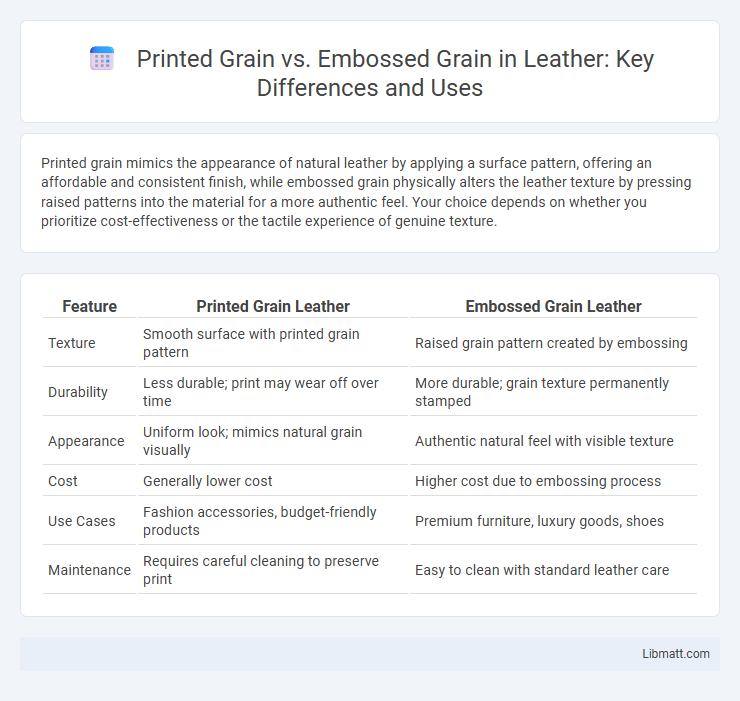Printed grain mimics the appearance of natural leather by applying a surface pattern, offering an affordable and consistent finish, while embossed grain physically alters the leather texture by pressing raised patterns into the material for a more authentic feel. Your choice depends on whether you prioritize cost-effectiveness or the tactile experience of genuine texture.
Table of Comparison
| Feature | Printed Grain Leather | Embossed Grain Leather |
|---|---|---|
| Texture | Smooth surface with printed grain pattern | Raised grain pattern created by embossing |
| Durability | Less durable; print may wear off over time | More durable; grain texture permanently stamped |
| Appearance | Uniform look; mimics natural grain visually | Authentic natural feel with visible texture |
| Cost | Generally lower cost | Higher cost due to embossing process |
| Use Cases | Fashion accessories, budget-friendly products | Premium furniture, luxury goods, shoes |
| Maintenance | Requires careful cleaning to preserve print | Easy to clean with standard leather care |
Introduction to Printed Grain and Embossed Grain
Printed grain leather features a surface pattern applied through ink or pigment printing techniques that mimic natural textures, providing a consistent and customizable appearance. Embossed grain leather is created by pressing a patterned plate into the leather using heat and pressure, resulting in a textured, three-dimensional surface that enhances durability and tactile feel. Both methods aim to replicate natural grain aesthetics while offering distinct visual and tactile properties for various leather products.
Defining Printed Grain: Process and Features
Printed grain leather involves applying a synthetic grain pattern onto the surface of genuine or bonded leather through a heat transfer or stamping process, enhancing its aesthetic appeal and uniformity. This method replicates natural leather textures, allowing consistent grain patterns that can be customized in color and design. The key features include enhanced durability, resistance to wear, and a smoother surface compared to natural grain but without the depth of texture found in embossed grain leather.
Understanding Embossed Grain: Techniques and Benefits
Embossed grain leather is created by pressing a textured pattern onto the surface using heat and pressure, enhancing durability and providing a consistent, natural-looking finish compared to printed grain. This technique replicates the natural grain patterns without compromising the leather's structural integrity, making it ideal for high-quality upholstery, footwear, and accessories. Understanding embossed grain helps you choose products with superior wear resistance and authentic texture tailored to your style needs.
Key Differences Between Printed and Embossed Grain
Printed grain mimics the texture of natural leather through surface patterns applied with ink, offering visually diverse designs but lacking tactile depth. Embossed grain creates a raised, textured pattern by pressing the leather with heat and pressure, providing a genuine feel similar to natural grain. The key difference lies in tactile authenticity, where embossed grain delivers true texture, and printed grain offers only a visual effect.
Visual and Tactile Appeal: Comparing Surface Textures
Printed grain leather features a smooth, consistent surface with a uniform grain pattern that enhances visual clarity but lacks natural texture, making it less tactilely engaging. Embossed grain leather replicates the natural grain through raised patterns, offering a textured surface that appeals to the sense of touch and adds depth to the material's appearance. Your choice depends on whether you prioritize the sleek look of printed grain or the rich, tactile dimension of embossed grain.
Durability and Longevity: Which Grain Lasts Longer?
Embossed grain leather offers superior durability and longevity compared to printed grain, as its texture is deeply stamped into the material, enhancing resistance to wear and tear. Printed grain leather, primarily a surface treatment, tends to fade and peel over time due to its thinner coating, making it less durable. Your investment in embossed grain ensures a longer-lasting, more resilient leather product ideal for everyday use.
Applications: Where Printed vs Embossed Grain Are Used
Printed grain surfaces are commonly utilized in fashion accessories, automotive interiors, and electronic device casings due to their cost-effective customization and detailed texture replication. Embossed grain is preferred in luxury leather goods, high-end furniture upholstery, and automotive seating for its durable tactile depth and authentic leather feel. Both techniques enhance aesthetic appeal, but embossed grain is favored where longevity and tactile authenticity are critical.
Cost Considerations: Economic Factors to Evaluate
Printed grain leather typically costs less due to the simpler manufacturing process, making it a budget-friendly option for mass production. Embossed grain leather involves additional steps to imprint natural textures, increasing labor and equipment expenses, which results in higher prices. Evaluating cost considerations requires balancing initial investment against desired texture authenticity and product longevity.
Environmental Impact: Sustainability of Each Process
Printed grain leather involves applying synthetic inks and coatings, which often contain volatile organic compounds (VOCs) contributing to air pollution and waste generation during production. Embossed grain leather uses mechanical processes to imprint textures onto the leather surface, generally producing less chemical waste and relying more on energy consumption, which can be mitigated with renewable sources. Sustainability in embossed grain production tends to be higher due to reduced use of harmful chemicals, though both methods' overall environmental impact depends on the tanning processes and supply chain practices involved.
Choosing the Right Grain for Your Project
Printed grain offers consistent patterns ideal for mass production and smooth surfaces, while embossed grain provides a textured, tactile finish that enhances grip and visual depth. Selecting the right grain depends on the project's aesthetic and functional needs, with printed grain suited for sleek designs and embossed grain favored for durability and a premium feel. Consider application, budget, and user interaction to determine whether a flat or raised texture better complements your design vision.
Printed grain vs embossed grain Infographic

 libmatt.com
libmatt.com